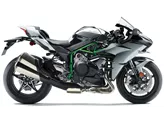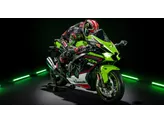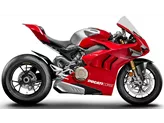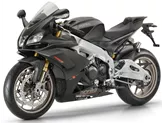Kawasaki Ninja H2 2015 vs. Aprilia RSV4 1100 Factory 2021

Kawasaki Ninja H2 2015

Aprilia RSV4 1100 Factory 2021
Overview - Kawasaki Ninja H2 2015 vs Aprilia RSV4 1100 Factory 2021
The Kawasaki Ninja H2 model year 2015 and the Aprilia RSV4 1100 Factory model year 2021 are both high-performance supersport motorcycles that offer impressive power and advanced features.
Starting with the Kawasaki Ninja H2 2015, it boasts a powerful in-line engine that produces 200 HP and 133.5 Nm of torque. The engine is equipped with DOHC valves and has a displacement of 998cc. The bike features a telescopic fork front suspension with adjustable compression, preload, and rebound settings. The rear suspension also offers adjustable compression, preload, and rebound. The frame is made of steel, providing a sturdy and reliable structure. The front brakes are double disk with radial technology. The front tire has a width of 120 mm and a diameter of 17 inches, while the rear tire has a width of 200 mm and a diameter of 17 inches. The wheelbase measures 1455 mm, and the seat height is 825 mm. With ABS, the bike has a kerb weight of 238 kg and a fuel tank capacity of 17 liters.
On the other hand, the Aprilia RSV4 1100 Factory 2021 is equipped with a V-type engine that delivers an impressive 217 HP and 122 Nm of torque. Like the Kawasaki Ninja H2, it has a DOHC valve system and features a displacement of 1099cc. The front suspension is an upside-down telescopic fork with adjustable compression and rebound settings. The rear suspension also offers adjustable compression, preload, and rebound. The frame is made of aluminum, which provides a lightweight and agile ride. The front brakes are double disk with radial and monoblock technology. The front and rear tires have the same dimensions as the Kawasaki Ninja H2. The wheelbase measures 1420 mm, and the seat height is 851 mm. With ABS, the bike has a kerb weight of 199 kg and a fuel tank capacity of 18.5 liters.

Kawasaki Ninja H2 2015
In terms of strengths, the Kawasaki Ninja H2 2015 is praised for its outstanding build quality and the fascinating engine with a mechanical turbocharger. The bike offers exceptional pull, acceleration, and speed, taking performance to a whole new level. The narrow seat ensures safe standing, even for smaller riders, and the bike provides great stability. Despite its high performance, the Ninja H2 inspires confidence and has strong brakes. It also features high-quality details that add to its appeal.
On the other hand, the Aprilia RSV4 1100 Factory 2021 is commended for its great electronic chassis, which offers a playfully perfect set-up directly from the showroom. The bike's engine is incredibly powerful, and it provides a wonderful feeling for the front wheel. The seating position is comfortable, and it allows for easy and fast lap times even in standard condition.

Aprilia RSV4 1100 Factory 2021
However, there are some weaknesses to consider. The Kawasaki Ninja H2 2015 has been criticized for its response behavior in the transition from pushing mode to acceleration phase, which is not at the level of "normal" motorcycles. It also experiences understeer in fast bends, and taller riders above 185 cm may find it difficult to integrate their feet into the overall aerodynamic concept.
Similarly, the Aprilia RSV4 1100 Factory 2021 has a few weaknesses. Some riders have found the standard transmission to be slightly too long, and the clutch lever has been described as cheap-looking. The quickshifter requires discipline for perfect function, and the screen display is considered coarse.
In conclusion, both the Kawasaki Ninja H2 2015 and the Aprilia RSV4 1100 Factory 2021 are impressive supersport motorcycles with their own strengths and weaknesses. The Ninja H2 offers outstanding build quality, a powerful engine, and high-quality details. The RSV4 1100 Factory boasts a great electronic chassis, a powerful engine, and a comfortable seating position. Riders should carefully consider their preferences and priorities to choose the bike that best suits their needs.
Technical Specifications Kawasaki Ninja H2 2015 compared to Aprilia RSV4 1100 Factory 2021
Pros and Cons in comparison
Pros and Cons in comparison
Kawasaki Ninja H2 2015

The Ninja H2 represents a milestone in motorbike history. It is not only packed with electronic innovations, but also offers completely new technologies in terms of engine construction and mechanics. This high-tech research object of a Japanese technology company is actually for sale and can also be ridden. Basically, it rides like a normal motorbike, only with considerably more power. At first, the engine response is a challenge, but speed freaks will find a way to ride and enjoy this fascinating motorbike.
Aprilia RSV4 1100 Factory 2021

You want a motorbike that serves you good lap times without a single movement and without any further investment? Then take the Aprilia RSV4 Factory. Out of the box, it's the bike that hits the fast line the easiest, giving hobby racers and energetic riders instant good lap times. On corner exit, the power can be used even better in 2021 - the new ECU does a good job. The exclusive dream bike from Noale has been made better once again.
Price Comparison Avarage Market Price Kawasaki Ninja H2 vs Aprilia RSV4 1100 Factory
There are a few key differences between a Kawasaki Ninja H2 2015 and a Aprilia RSV4 1100 Factory 2021. In terms of price, the actual average price of a Kawasaki Ninja H2 2015 is about 19% higher. Compared to Aprilia RSV4 1100 Factory 2021 there are less Kawasaki Ninja H2 2015 bikes available on the 1000PS.de Marketplace, specifically 4 compared to 7. It takes less time to sell a Aprilia RSV4 1100 Factory with 135 days compared to 153 days for the Kawasaki Ninja H2. Since model year 2015 1000PS.de editors have written 27 reviews for the Kawasaki Ninja H2 and 15 reviews for the Aprilia RSV4 1100 Factory since model year 2019. The first review for the Kawasaki Ninja H2 was published on 8/31/2014 and now has more than 5,600 views. This compares to more than 61,300 views for the first review on Aprilia RSV4 1100 Factory published on 11/3/2018.













/gr.jpg?format=webp&quality=80&trim.threshold=80&trim.percentpadding=1&width=164&height=123)
















